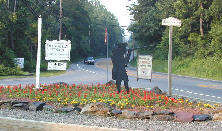FISHKILLNEW YORK |
 |
FISHKILLNEW YORK |
 |
 During
the Revolution, Fishkill was the site of a large supply depot. The depot
supplied the northern department of the Continental Army, who were responsible
for securing the Highlands and keeping the British from moving north of New York
City. There are several historical sites to see in Fishkill. The first is here
at Mount Gulian.
During
the Revolution, Fishkill was the site of a large supply depot. The depot
supplied the northern department of the Continental Army, who were responsible
for securing the Highlands and keeping the British from moving north of New York
City. There are several historical sites to see in Fishkill. The first is here
at Mount Gulian.
Mount Gulian — The Mount Gulian, Ver Planck homestead is a circa 1750 Dutch colonial overlooking the Hudson. During the final days of the Revolution, it was the headquarters of General von Steuben, inspector general of the Continental Army in 1783. Steuben is given credit for turning the Continental Army into a strong, fighting force with his training at Valley Forge.
| Mount
Gulian
Built about 1750 by Gulian Ver Planck whose ancestors and Francis Rombout purchased the adjacent land from the Wappinger Indians in 1605. Headquarters of Baron Von Steuben. The Society for the Cincinnati was instituted here May 1765. Placed by the Colonial Dames of the State of New York. MDCCCXCIX (Mount Gulian Marker) |
|
In 1783, the nation’s first veterans group, the Society of the Cincinnati, was formed at the Mount Gulian site.
Today, the Mount Gulian homestead offers educational programs and special events for the public to enjoy. For example, in September, they offer a Revolutionary War living history weekend with special visits by George Washington and Thomas Jefferson.
Dutch Reformed Church — The church housed prisoners of war during the American Revolution. Between September 1776 and February 1777, it served as the seat of state government when the British forced the New York Provincial Congress out of New York City and White Plains.
| Dutch
Church
Reformed church of Fishkill, organized 1716, built 1725 occupied 1776 by New York Provincial Congress, also a prison during Revolution. State Education Department 1935 (Church Marker) |
|
Trinity Episcopal Church — The church also served as part of the New York State government and as a military hospital during the American Revolution.
| Trinity
Church
Organized in communion with the Church of England by the Rev. Samuel Seabury, 1756. The first rector Rev. John Beardsley, Oct. 26, 1766. Reincorporated, Oct. 13, 1785 and Oct. 16, 1796. This building was erected about 1769. Occupied by the New York Provincial Convention which was removed from White Plains, Sept. 3, 1776. Used for a military hospital by the army of General Washington until disbanded, June 2, 1783. Pro Deo et Patria, 1756 — 1894. (Church Marker) |
|
Van Wyck Homestead — The homestead is a restored Dutch colonial that housed officers of Washington's army. It was also the army's northern supply depot headquarters and is reputedly the setting for James Fennimore Cooper's The Spy. It contains portraits by Ammi Phillips as well as artifacts from the Fishkill Depot and Barracks.
| Fishkill
Encampment
1776-1783 In adjoining fields, barracks were built by Gen. Gates under orders of George Washington to accommodate an encampment of over 2,000 soldiers. The Van Wyck home served as Army Headquarters for Gen. Gates, Gen. Putnam and Col. Hay. Frequent meetings were held here by Lafayette, Von Steuben, John Jay, Alexander Hamilton and other patriots. (Van Wyck Marker) |
|
Today, the Van Wyck Homestead is obviously near the intersection of two very busy highways, US Route 9 and I84. In colonial times the homestead was on the Albany to New York Post Road. The road was established in 1772 and provided weekly mail service and covered wagon, passenger service in the mid 1780’s. A Post Road Marker can be seen just south of the house near the shopping center. A marker at the homestead describes the Indian trading path that existed here prior to colonial times.
| Great Indian Warrior
Trading Path
The most heavily traveled road in Colonial America passed through here, linking areas from the Great Lakes to Augusta, GA. Laid on ancient animal and Native American Trading/Warrior Paths, Indian treaties among the governors of NY, PA, and VA and the 19 chiefs of Iroquois League of Five Nations in 1685 and 1722, opened the colonial backcountry for peaceful settlement and colonization. In NY, the path linked the Iroquois and the Great Lakes to the major eastern trails and tribes for trade, hunting and war. National Society Daughters of the American Colonists. Project of the 2000-3 Administration. (Van Wyck Marker) |
Wappingers Falls. In the center of town is Mesier Park. Inside the park is the 18th century, Mesier Homestead.
| Mesier
Park
Pre-Revolutionary home of the Mesier family from 1777 to 1890 acquired by village 1891. On May 1, 1777, this dwelling with a farm of about four hundred and twenty two acres of land on which it stood was conveyed to Peter Mesier of New York City by Nicholas Brewer, who had owned the property since October 9, 1741. It became the residence of the Mesier family and was known as the Mesier homestead until August 27, 1891, when it was conveyed with a plot of five acres of the land to the village of Wappingers Falls under an agreement that the property should be forever known as Mesier Park. State Education Department 1935 (Wappingers Falls Markers) |
|
